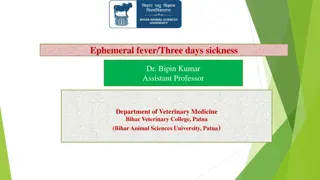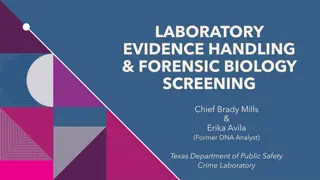Comprehensive Overview of Molecular Diagnostics, Cytogenetics, and Forensic Biology
Explore a detailed curriculum covering molecular diagnostics, traditional disease diagnosis methods, genetic disorders, cytogenetics, molecular techniques, biochemical tests, PCR applications, immunoassays, and forensic biology including microbial forensics, entomology, botany, serology. Lectures co
1 views • 4 slides
Ephemeral Fever/Three-Day Sickness in Cattle and Water Buffalo
Ephemeral fever (Three-Day Sickness) is an acute arthropod-borne viral disease affecting cattle and water buffalo. It is caused by the Bovine Ephemeral Fever Virus and manifests with biphasic fever, decreased milk yield, and other clinical signs. The disease has varying prevalence and can lead to hi
0 views • 7 slides
Uveitis Case Presentation: Comprehensive Overview for Effective Management
This uveitis case presentation provides a detailed examination of a patient's history, clinical findings, relevant investigations, and current management plan. The information includes a concise overview of the uveitis history, intraocular fluid analysis, serology results, past medical history, and
1 views • 19 slides
Rickettsia: Pathogenesis, Clinical Manifestations, and Diagnosis
Rickettsia, a genus of Gram-negative bacteria transmitted by arthropods, is responsible for diseases like Rocky Mountain spotted fever. It causes symptoms such as high fever, rash, and severe headache. Laboratory diagnosis involves serology and isolation from experimental animals. Learn more about R
1 views • 9 slides
Unusual Case of Fever with Gastrointestinal Symptoms in a 22-Year-Old Patient
A 22-year-old male from Pune presents with high-grade fever, chills, myalgia, arthralgia, loose stools, and vomiting for 2 days. Past history is unremarkable, while the family history includes hypothyroidism in the mother and hypertension in the father. General examination reveals normal vital signs
0 views • 22 slides
Viral Specimen Selection and Collection Overview
Specimen selection for viral testing depends on the suspected viral etiologies and disease syndrome. Throat and nasopharyngeal swabs are used for different viruses, while rectal swabs, urine, blood, and tissue samples are also collected for specific viral detection. Proper specimen transport and sto
0 views • 7 slides
Laboratory Evidence Handling & Forensic Biology Screening Overview
This document provides information on the case acceptance policy, evidence handling practices, and forensic serology screening procedures at the Texas Department of Public Safety Crime Laboratory. It outlines the limitations and guidelines for DNA testing, types of evidence accepted, and the number
0 views • 13 slides
Medical Laboratory Testing Guidelines in Toronto Healthcare Facilities
This document outlines the specific tube colors, volumes, and labeling instructions for serology and HLA testing at Toronto Medical Laboratories (TML) and the Hospital for Sick Children. It includes details on sample collection, handling, and delivery procedures for different patient categories. The
0 views • 22 slides
Streptococci: Classification and Characteristics
Streptococci are Gram-positive cocci commonly found in chains or pairs. This article covers their classification based on hemolysis patterns and Lancefield grouping, along with general characteristics and principles of differentiation tests. Learn about the infections caused by different Streptococc
0 views • 39 slides
Medically Important Hemoflagellates: Trypanosoma and Leishmania
Hemoflagellates belong to the phylum Sarcomastigophora and include medically significant genera such as Trypanosoma and Leishmania. These parasites are transmitted by insects and exhibit complex life cycles. Trypanosoma species, such as T. cruzi and T. brucei, cause diseases like Chagas' disease and
0 views • 18 slides
Evolutionary Evidence in Biology
Fossil records, comparative embryology, anatomy, convergent and divergent evolution, cell biology, and serology provide compelling evidence for common ancestry and evolutionary relationships among organisms. Fossils offer a glimpse into the past, while comparative studies highlight similarities in s
0 views • 7 slides
Management of Anti-e Late Sensitization in Pregnancy: A Case Study
A detailed case study involving a pregnant patient with anti-e late sensitization, suspected HDFN, and challenging component selection decisions. The patient's history, serology results, obstetric background, and sequence of events leading to an urgent transfer of the infant to a specialized hospita
0 views • 15 slides
Comprehensive Laboratory Services at Agrivet Research & Advisory Private Limited
Agrivet Research & Advisory Private Limited, formerly known as Agrivet Consultancy Pvt. Ltd., offers a wide array of laboratory services encompassing traditional wet chemistry, microbiology, serology, and biochemical techniques to advanced metagenomics and transcriptomics. With a focus on research a
0 views • 16 slides
Agglutination Test in Laboratory Methods
Agglutination test is a vital laboratory method for detecting antigen-antibody reactions. It involves a two-step process of sensitization and lattice formation, resulting in visible clumping or agglutination. This test is versatile, providing a semi-quantitative measure of antigen or antibody concen
0 views • 13 slides
Study on Congenital Syphilis in Papua New Guinea
Syphilis, a sexually transmitted infection caused by Treponema pallidum, remains a global health concern, especially in mother-to-child transmission. This study aims to determine the outcomes of neonates born to mothers positive for syphilis, exploring the proportion of symptomatic versus asymptomat
15 views • 26 slides














